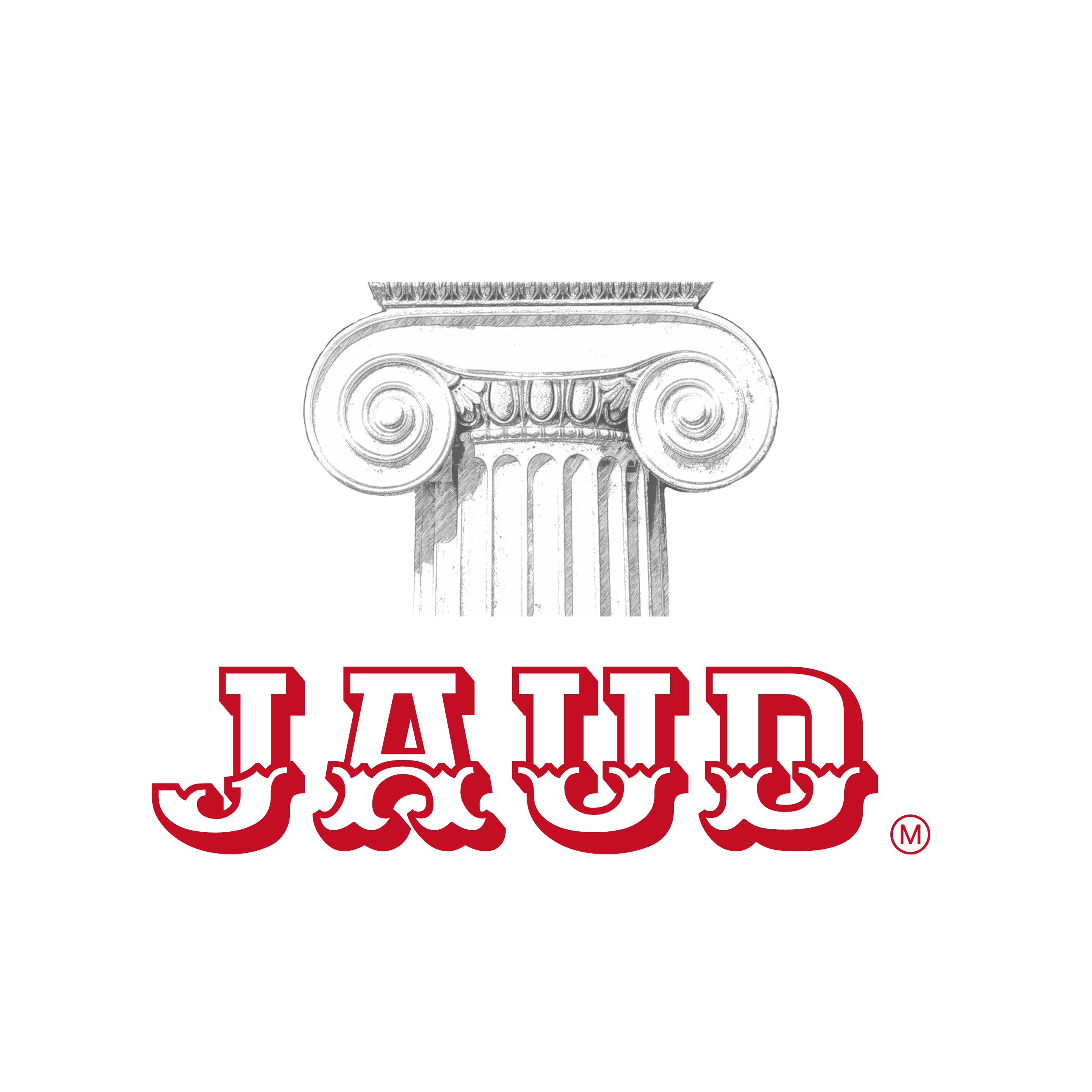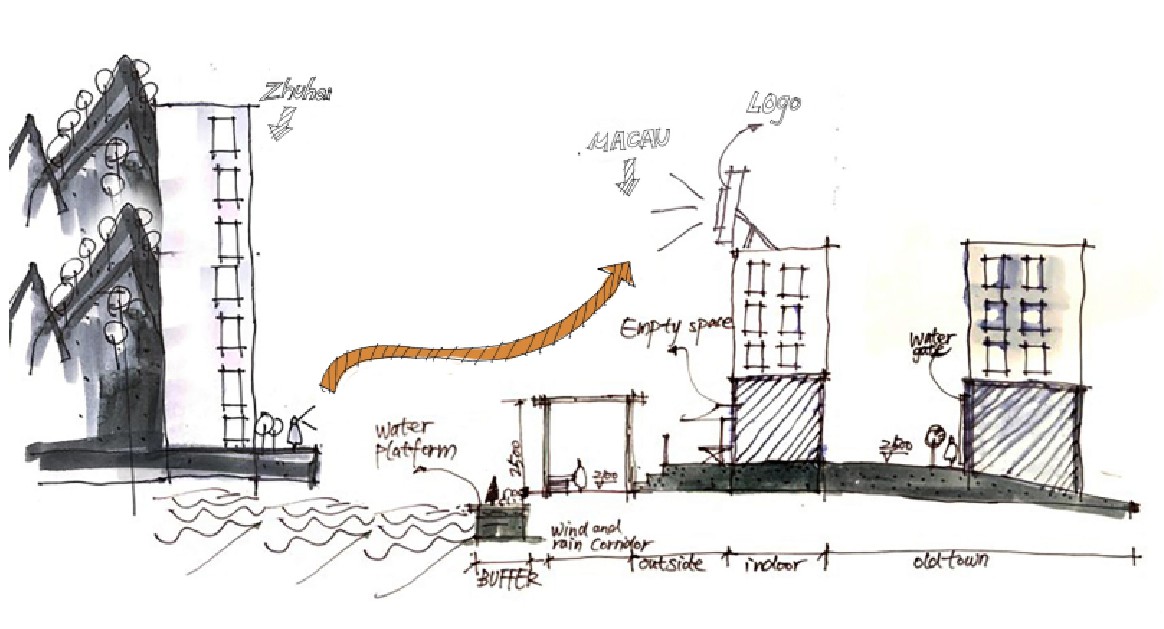Ecological restoration and vitality regeneration strategies in the Macau Inland Port area
3.1 Transformation from Traditional Design Thinking to Ecological Design Thinking
Waterfront space is not simply beautifying the environment by adding landscape greening space, but reflecting on the ecological and connectivity of urban waterfront space in the future from traditional design methods. In the early stages of urban development, there was also a phenomenon of disorder and excessive development in the construction of waterfront spaces in Macau. This was due to insufficient understanding of waterfront landscapes and a lack of scientific and sustainable development concepts. The waterfront space was simply understood as a symbol of urban style, and a large number of reclamation projects straightened the winding coastline, built tall and sturdy seawalls, and formed a large area of artificial landscape. These early planning models did indeed meet the needs of urban construction at that time, seemingly solving the problems of waterfront space and natural ecology. However, this dichotomy is not suitable for the development needs of cities in the long run, resulting in the separation of waterfront spaces and natural systems, losing their original functions of purification and energy flow and transformation between ecosystems, and thus damaging ecological diversity.
Various signs indicate that the single construction thinking of waterfront spaces in the past cannot meet the sustainable development needs of Macau's cities in the future. Based on the direction of renewal and development in Macau, China in the next 20 years, the author believes that landscape ecological design thinking can be used to construct and update waterfront spaces. Based on ecological protection and resource conservation, natural laws should be utilized to construct waterfront areas with ecological functions, and the impact and changes brought by nature to the environment should be viewed with an open attitude. At the same time, in accordance with the natural waterfront environment, the functions of waterfront ecology should be reasonably utilized, unfavorable elements should be transformed into usable elements, and a harmonious and symbiotic urban waterfront ecological landscape should be constructed.
An Overview of the Causes and Current Situation of the Decline in the Macau Inland Port Area
2.1 Causes of decline in the Macau Inland Port area
"The Inner Harbor Waterfront Area of Macau is located on the west side of the Macau Peninsula, and is the oldest and earliest developed port area in Macau. Its coastline has been gradually reclaimed and developed from the 19th century to the 1930s, forming the current pattern of" one water and two banks "from the old city of Inner Harbor to Zhuhai Wan Chai. The Inner Harbor Area of Macau is mainly composed of 34 freight, inland waterway transportation, and fishing docks, ranging from Lighthouse 12 to Chopsticks Base, with a length of about 3500 meters. It is bounded by Chopsticks Base and the Inner Harbor Waterfront Area in the north, and extends to the navigation school area in the south. In the east, the old city space of Inner Harbor is divided into Basudar Ancient Street, Huobotou Street, and Hebian New Street." The boundary between port and city. [3] Since the 1980s, there have been large-scale changes in the morphology of the Macau Inland Port area, caused by the issue of common ownership of land parcels in the area. Constrained by this land allocation system, residents use their own methods to solve their living and survival problems, leading to frequent illegal and disorderly construction in the area, seriously affecting the spatial development of the Inner Harbor area. [4] "Due to the complex land ownership relationship formed under the early Portuguese Chinese co governance, private land and leased land were mixed, and the ownership of small plots was dispersed, which posed certain obstacles to the large-scale consolidation and development of land. As Portuguese scholar Alfonso said, this" illegal "land block allocation system was not based on the set and true land division in urban planning, and the" spontaneous "behavior of the people dominated. This made the Macau SAR government feel a bit" at a loss "when proposing rectification and planning for the area in the future, hindering the planning and renewal of historical urban areas.".
The decline of Inner Harbor was essentially the result of the overall economic and industrial transfer of Macau, China at that time. Specifically, factors such as the land allocation system, street alignment system, and building hierarchical ownership system collectively led to the disorderly competition in the development of Inner Harbor's urban form. The policies, regulations, and complex land system in Macau, China have directly affected the urban form and business model of the port, and even affected the revitalization of the region. Another reason for the economic recession in Inner Harbor was the strong development of the gambling tourism industry in Macau, China at that time, which led to the industrial contraction of Inner Harbor. Most of the industrial and manufacturing industries shifted to the Pearl River Delta. Driven by various reasons, Inner Harbor gradually lost its original role as a core commercial area of the city. Until after 2000, the industry in the inner port had completely relocated, leaving the transportation terminals and inner port area that were already in decline in an abandoned state, and the ecological environment was gradually deteriorating.
In 2019, the Macau SAR government proposed to build a tidal barrier in the waterway between Ma Ge and Wan Chai to address the long-term problem of flooding in the inner harbor and improve the hydrological and ecological environment, in order to resist flooding and seawater backflow caused by typhoons and special weather conditions. In 2019, Ou Bingguang, a civil engineering laboratory in Macau, believed at the Second Coastal Urban Planning and Design Forum that the construction of tidal gates would cause more pollution and have a certain impact on the ecological environment, water environment, atmospheric environment, and even acoustic environment within the project area. The author also believes that when the seawater in the Wan Chai Waterway rises and the terrain of the inner port is below sea level, seawater will flow back into the inner port area. Tidal barriers can only prevent seawater from flowing back on the outer sea side, but they do not have a blocking effect on seawater flow back into the inner port, which will also cause seawater to flow back into the inner port from other areas. Therefore, the implementation of this plan is not a foolproof solution. In the long run, building a tidal barrier may cure symptoms of seawater backflow, but it cannot fundamentally solve the problem of ecological loss in the inner harbor area, let alone activate the functional use of the inner harbor area to achieve vitality regeneration.
The inner port area of the Macau Peninsula is the border of Macau, China, facing Zhuhai Wan Chai across the shore. For it, it is the window and image display for the city to the outside world. Therefore, the planning of waterfront landscapes should focus on the artificial beauty of cultural landscapes as a window for Macau, China to showcase its image to the outside world. At the same time, it should also pay attention to the natural beauty of the waterfront spatial ecosystem, and design it as a key place for residents and tourists to serve. However, in the past, the design and treatment of the waterfront interface of the inner port terminal were rigid, without considering the ecosystem or artistic design techniques, resulting in a lack of landscape interest and aesthetic creation, and a natural loss of the ecosystem. On the other hand, the location of the freight terminal is between the inland sea and residential areas, which creates a barrier in space and limits the flexibility of activities and living behaviors of residents in the old city, causing communication and interaction between people and water bodies to be unable to unfold, resulting in a situation of spatial fragmentation.
The Inner Harbor area is also constrained by the limited spatial scale of the old urban area in terms of transportation. As the main road, the width of the new road is only 10 meters, and the scale of the Inner Street is even smaller. The cargo function of the dock, public transportation, and pedestrian space occupy and interfere with each other, and the way of ground parking affects the dynamic transportation system in the area. People and vehicles cannot be separated, resulting in a chaotic and crowded scene in the area. The number of pedestrian overpasses that connect the area is also limited, which to some extent limits the accessibility and safety of residents and tourists walking.
Introduction
With the development of the times and the adjustment of the port industry structure, the domestic port terminals in Macau, China have gone through a process of prosperity to decline, which witnesses the historical changes of domestic port shipping. Since 1998, due to factors such as the relocation of casinos, reduced fishing transportation, and the opening of Kowloon Ferry Terminal in Hong Kong and Macau Deep Water Port, commercial activities in the inner port have been decreasing, leaving people and buildings empty, gradually forming a semi abandoned state, resulting in ecological deficiencies in the inner port and dock areas. Looking at the overall environment, the current development of Macau, China is also constrained by factors such as economy, population, land, ecology, and the epidemic. The infrastructure, landscape green spaces, ecological environment, and commercial services in historical urban areas cannot meet the needs of future urban development.
The once bustling and bustling scene of the inner port of Macau, China has become a thing of the past, which contradicts the current positioning of Macau as a modern tourist city and a "world dynamic city", resulting in ecological damage and the emergence of a large amount of industrial waste land. On the other hand, under the influence of the COVID-19 in the past two years, the number of tourists in Macao has dropped sharply again, once at a standstill, which has had a great impact on the tourism revenue of Macao, China. This article proposes that the revitalization and restoration of ecologically deficient areas in old urban areas are carried out under the guidance of urban renewal in Macau. On the one hand, it focuses on the future development needs of the city, and from a strategic perspective, it pays attention to regional linkage, ecological restoration, and vitality enhancement; On the other hand, attention should be paid to the condition of the site and the functional updates of the regional space, in order to reduce the impact and harm caused by various changing factors, thereby enhancing the spatial vitality of the region and promoting economic development.
Guidelines for Urban Renewal Needs
The long-standing issues of ecological maintenance and functional renewal in the inland port area of Macau have yet to be resolved, and diversified development will become empty talk. From an ecological perspective, the extensive use of artificial hard land reclamation in the past has resulted in narrower waterways and the occurrence of seawater backflow and waterlogging in the inner harbor. More and more experts and scholars are paying attention to this and proposing strategies to solve the problem of water disasters in inland ports. Among them, scholars such as Liu Yang and Fei Yingqing (2016) proposed methods to solve the problem of water disasters in inland ports in their article "Research on Waterfront City Flooding Countermeasures - Taking Macao's Inner Port as an Example", in order to increase the concept of "soft connected" sponge cities and provide suggestions for their transformation and upgrading. Gao Jianghan, Long Yuan, and others have also proposed an overall design strategy of "open space" as the main focus for the renovation of the inner port area, providing valuable reference for the future planning and design of waterfront spaces in old urban areas.
For a long time, in order to improve the urban difficulties in Macau, promote economic and tourism development, the Macau SAR government has also issued multiple planning outlines and guiding documents based on Macau's urban renewal. The Macau Urban Conceptual Planning Outline (2008) clearly defines the development goal of building Macau, China into a "world dynamic city", and proposes to maintain its original urban characteristics, shape new highlights of urban space, and enhance urban spatial vitality in the process of Macau's urban renewal. [1] In September 2020, due to the future development needs of the city, the Macao Special Administrative Region Government formulated the draft of the "Macao Special Administrative Region Urban Master Plan (2020-2040)", proposing to develop urban zoning and land improvement plans, in order to create a coordinated urban spatial structure, continuously promote urban development goals, and improve the comprehensive environmental quality of green, livable, and tourist friendly cities. In response to the renewal of old urban areas, the draft also proposes relevant strategies to promote the revitalization of old areas, and combines disaster prevention and reduction planning to promote the sustainable development of historical urban areas. Further, a long-term renovation plan will be carried out based on the actual situation of the inner port, in conjunction with the construction of coastal commercial streets or waterfront hubs, improving commercial formats, enhancing regional vitality, and revitalizing the economy. [2]
From this, it can be seen that in the face of these constantly changing social, environmental, climate, and economic factors, the Macau SAR government has proposed policy guidelines for the restoration and functional renewal of historical urban areas on the Macau Peninsula, aiming to reduce the impact of various changes on the old urban areas. I hope to use a new planning scheme to enable the affected sites to quickly reorganize and restore themselves, including management and control of rainfall and climate, ecological function restoration and restructuring, and adaptation to the needs of future regional development, so as to revitalize their functions and vitality, promote regional economic recovery and vitality enhancement.
2.2 Overview of the Current Situation of Macao's Inner Harbor Area
In terms of flood protection, the Inner Harbor has its inherent shortcomings, such as low-lying terrain, insufficient urban drainage system, year-round impact from climate and typhoons, and the low existing flood control standards, which have led to frequent water disasters and waterlogging in the region. In terms of ecological protection, the shortage of public and green spaces, the destruction of natural shorelines, and the impact of seawater backflow have caused serious ecological deficiencies (Figure 1). The Inner Harbor area was hit by strong typhoons "Tiange" and "Shanzhu" in 2017 and 2018, causing the area to be almost submerged in water to the waist, with the highest water level reaching nearly 2 meters, causing serious impacts on the work and life of residents in the area.
Abstract
In the process of urbanization, the development and transformation of cities are influenced by different factors, leaving behind various places with ecological deficiencies. The inland port area of the Macau Peninsula has undergone changes from prosperity to decline in the process of renewal and development in Macau, China. The old functions of public spaces in the city have conflicted with the needs of the current era, and there are various phenomena of dilapidation and ecological loss. The article analyzes the causes and current situation of the decline of the Macau Inland Port area, and proposes relevant regional ecological restoration and vitality regeneration strategies based on the demand orientation of the Macau SAR government for urban renewal in the next 20 years, so as to revitalize its new functions and vitality.
© 2023 by the authors. Published by Michelangelo-scholar Publish Ltd.
This article is published under the Creative Commons Attribution-NonCommercial-NoDerivs 4.0 International (CC BY-NC-ND, version 4.0) license (https://creativecommons.org/licenses/by-nc-nd/4.0/), which permits non-commercial use, distribution, and reproduction in any medium, provided the original work is properly cited and not modified in any way.
Article Metrics
Waiting for update.
Share and Cite
Chicago/Turabian Style
Yishan Mao, "Research on Vitality Enhancement and Restoration Strategies of Ecological Deficiency Sites from the Perspective of Urban Renewal. "JAUD 1, no.1 (2024): 32-40.
AMA Style
Yishan Mao. Research on Vitality Enhancement and Restoration Strategies of Ecological Deficiency Sites from the Perspective of Urban Renewal. JAUD. 2024; 1(1): 32-40.
Table of Contents
- Abstract
- Introduction
Guidelines for Urban Renewal Needs
An Overview of the Causes and Current Situation of the Decline in the Macau Inland Port Area
Ecological restoration and vitality regeneration strategies in the Macau Inland Port area
- Conclusion
- Conflicts of Interest
- References
3.2 Building functional buffer zones to flexibly solve water problems
A city is a dynamic and changing process, as well as a carrier that carries natural and social processes. With its continuous development and changes, it can reconcile the internal problem relationships between various factors. Therefore, updating the functions of the inland waterfront space in Macau, China, must be implemented from a dynamic development perspective, combined with other urban influencing factors, to alleviate the prominent problems of the inland waterfront space and solve them flexibly. The author believes that proposing the construction of functional buffer zones can divert rainwater discharge and urban drainage issues, and constructing the surface in a "sponge city" way can reduce the occurrence of water hazards. The approach of "sponge cities" is to combine natural pathways with artificial measures, while ensuring the safety of urban drainage and flood prevention, to maximize the accumulation, infiltration, and purification of rainwater in the inner port area, promote the utilization of rainwater resources and ecological environment protection, coordinate the systematic nature of natural precipitation, surface water, and groundwater, coordinate the various links of water cycle utilization such as water supply and drainage, and consider their complexity and long-term issues, playing a role in coordinating the ecological environment of the inner port area. [5]
In addition, to establish a model of flood control buildings to prevent seawater intrusion or "resolve" flood invasion, a combination of flood control facilities, drainage facilities, traffic diversion, and public entertainment functions can be considered in terms of functionality. While meeting the functional requirements, flood control buildings can be used to construct vertical and functional buffer zones. Rain and flood, as a natural factor, bring serious harm to the low-lying inner harbor area. The elastic approach of "sponge cities" provides a reference method for solving water problems. The rainwater formed during rainfall is slowly discharged into the municipal pipeline network through overflow outlets, effectively reducing runoff and reducing the probability of urban waterlogging.
3.3 Creating vibrant waterfront recreational spaces and creating a waterfront leisure and lifestyle coastline in the inner harbor
The renewal of recreational spaces in waterfront areas can attract people's arrival, providing an opportunity to get close to nature, allowing people to briefly break free from the constraints of the city and relax both physically and mentally. For the renovation of the waterfront recreational space in Macau, China, it is not only necessary to update the aging and abandoned functions, but also to adjust the functions according to the requirements of the times and people's use, so that the functions of the waterfront recreational space can be used normally. Updating and renovating vibrant waterfront recreational spaces cannot be simply achieved through basic usage functions. It is necessary to try different forms of environmental creation for waterfront spaces, enriching their functions. For example, using micro renewal art strategies to intervene in space renewal and cleverly activate the space can not only retain the original spatial texture and historical memory, but also increase the vitality of the space.
Therefore, the construction of the waterfront leisure and living shoreline in Inner Harbor needs to be considered in combination with cultural and spatial functions, taking into account the daily needs of citizens, such as public squares, pedestrian corridors, and leisure and recreational facilities. They should be interconnected to form a waterfront spatial form, forming a series of waterfront pedestrian systems and urban waterfront spaces. This will deepen the integration between squares, corridors, and facilities, and reduce the need for additional land. The key to creating waterfront spaces lies in people's participation and connectivity, reflecting people's hydrophilic goals. The connection between people and water should not only include the perceptual level (visual and tactile), but also the intimate relationship at the psychological level. Therefore, the design method can be adjusted reasonably according to different hydrophilic activities, so that people can integrate into the water environment while ensuring safety, and urban residents can better participate in hydrophilic activities, reflecting the charm of waterfront leisure life coastline. On the other hand, it is proposed to build ecological flood control facilities and buildings in waterfront spaces to mitigate the hazards caused by rainwater and waterlogging, in order to solve the construction problem of landscape infrastructure in the region.
3.4 Setting up the "Macao Brand Image" to Promote the Revitalization of the Inner Harbor Region
As mentioned earlier, the purpose of updating and renovating the inner port area is not only to enhance the ecological integrity of the site, but also to enhance the vitality of the region. Mainly through the flow of people and spatial behavior, residents and tourists are encouraged to come, increasing commercial activities, and forming sustainable spatial behavior and vitality factors. This article proposes to combine the activities of residents and tourists with commercial activities, divide the inner port into different areas, and combine new regional functions and vitality into landscape infrastructure to activate the idle space function of the inner port; On the other hand, to improve the previously abandoned space, functional loss, and commercial decline, and to repair this ecological and commercial waste site: by setting up an aesthetic "Macao brand image" for the functional planning of the inner port area, the hidden areas in various factors are added up, and the relevant spatial node functions are set up to solve the problems of the inner port.
The inner port of Macau faces Zhuhai Wan Chai, and the image of the inner port pier serves as a display window to promote Zhuhai across the shore. (Figure 2) The author attempts to design a brand image to be placed in the Inner Harbor commercial area. The large sign represents the commercial elements and brand culture of the Inner Harbor terminal, in order to attract residents and tourists with the brand culture. The eye-catching sign design stands at the top of the commercial area, with a strong visual impact effect. When designing and producing, concrete elements are mainly used, accompanied by neon lights, advertising boards, and other signs to add urban characteristics with a "gambling city" style. The reconstruction of the former urban landscape of Macau needs to match the image of Macau's gambling city, which not only satisfies the public's aesthetic and interest, but also enhances the attractiveness to tourists. This way, when people are in Zhuhai, they can clearly feel the cultural characteristics and updated scenery of Macau's inner port, which plays a good promotional role in activating the inner port.
School of Architecture, Suzhou University, Suzhou, China
* Author to whom correspondence should be addressed.
JAUD. 2024, 1(1), 32-40; https://doi.org/10.59528/
Received: February 21, 2024 | Accepted: April 2, 2024 | Published: April 13, 2024
Yishan Mao*
by
Research on Vitality Enhancement and Restoration Strategies of Ecological Deficiency Sites from the Perspective of Urban Renewal
References
1. Cai Yunnan, Yu Weikai, Wu Tianmou. Exploration of Overall Spatial Form Design in Macau Based on Urban Development Strategy [J]. Southern Architecture, 2008 (04): 38-40
2. Consultation Text on the Draft Urban Master Plan (2020-2040) of the Macao Special Administrative Region Government [M]. Macao: Land, Works, Transport Bureau, 2020
3. Gao Jianghan, Long Yuan, Fei Yingqing, et al. Urban design practice and reflection on the redevelopment of waterfront areas in Macau's inland port [J]. Chinese Landscape Architecture, 2018,34 (12): 78-83
4. Zheng Jianyi. Research on the Evolution of Urban Form in Macau's Inner Harbor [D]. South China University of Technology, 2017
5. Liu Yang, Fei Yingqing. Research on Waterfront Urban Waterlogging Countermeasures: A Case Study of Macau Inland Port [J]. Fujian Architecture, 2016 (05): 106-110
Conflicts of Interest
The author has no conflicts of interest with respect to the research, authorship, or publication of this article.
Conclusions
The gradual vacancy and abandonment of the inner port terminal have had a certain impact on the environment and residents' lives in the area, leading to various social, economic, and ecological issues. Based on an in-depth analysis of the cultural, ecological, and economic issues in Inner Harbor, the author believes that its renewal purpose should not only consider the inheritance and protection of culture, but also improve the ecological environment, optimize regional functions, develop the economy, and enhance regional vitality. Therefore, this article proposes innovative needs related to ecological restoration, functional restructuring, and life, transportation, and other aspects.
The urban renewal direction proposed by the Macau SAR government for the next 20 years has pointed out the direction for the overall urban renewal of Macau, and a long-term renovation plan has been proposed based on the actual situation of the inner port, with the aim of enhancing regional vitality and promoting the sustainable development of historical urban areas. This article proposes three strategies for regional ecological restoration, functional restructuring, and cultural inheritance based on the relevant situation of the Inner Harbor area: namely, the transformation from traditional design thinking to ecological design thinking; Build functional buffer zones to flexibly solve water problems; Create a vibrant waterfront recreational space and create a waterfront leisure and lifestyle coastline in the inner harbor; Set up a "Macau brand image" to promote the revitalization of the Inner Harbor region. Therefore, the Macau SAR government has proposed the goal of building coastal commercial streets or waterfront hubs, which can apply targeted strategies to activate the spatial functions of the inner port area, prevent further ecological deterioration, further improve the commercial formats of the inner port, and solve the problem of regional ecological deficiencies and promote the enhancement of urban spatial vitality.





